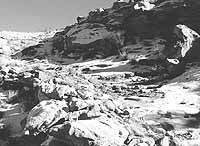| Junes Bottom is one of the roads which the state is aiming to get reopened with its lawsuit. |
The state of Utah and Emery County filed a lawsuit today asking a judge to reopen seven public roads that were shut down by the federal government. The lawsuit claims that the Bureau of Land Management illegally closed seven roads in Emery County.
“The state and Emery County already own these roads and we are simply asking the courts to remind the federal government of this fact,” says Governor Jon M. Huntsman.
The lawsuit is the latest effort of the Public Roads Over Public Lands Project, a joint effort among the Governor’s Office, the Attorney General’s Office and Utah’s counties to preserve state and local ownership and control of Utah’s established public roads over public lands. The project has filed lawsuits over seven other roads and is working with the BLM on six more roads.
“We are talking about roads that have been built and used by Utahns. It’s time for Utahns to get their roads back,” says Attorney General Mark Shurtleff.
Here is a brief description of the seven roads in question and some of their long-time uses:
•Mexican Mountain Road is 16 miles long and located in eastern Emery County. The road has been used for sightseeing, recreation, law enforcement, mineral exploration and search-and-rescue efforts.
•Seeger’s Hole Road is an 11 mile stretch in southwest Emery County. It has been used for sightseeing, recreation, law enforcement, mineral exploration and traveling.
•Sid’s Leap Road spans 6 miles in eastern Emery County. The road has been used for recreation, mineral exploration and search and rescue. It has also been used by visitors to see where Sid Swasey purportedly jumped his horse over a large chasm to avoid a sheriff’s posse at the turn of the century.
•Red Hole Draw Road is 2 miles long and located in western Emery County. Prior to its recent closure, the road was used for livestock management, sightseeing, recreation and traveling.
•Link Flat Road stretches 3 miles in southwest Emery County. The public used it for livestock management, sightseeing and mineral exploration.
•June’s Bottom Road is 6 miles long and located in southeastern Emery County near a scenic and historic part of the Green River. Until its recent closure, the road was used for sightseeing, recreation and mineral exploration.
•Copper Globe Road spans 14 miles near I-70 in southwest Emery County. The road provided access to the Copper Globe Mine in the early 1900s and has been used for ranching, hunting, sightseeing and prospecting.
The lawsuit is asking the courts to recognize state and local rights under R.S. 2477 a law that granted public rights-of-way across public lands. Congress repealed R.S. 2477 in 1976, but made it clear that every right-of-way already established under the statute was still valid. However, the BLM has since closed travel and road maintenance on R.S. 2477 roads in Emery County and other parts of the state. The BLM has also taken the position that using or maintaining the roads would be trespassing.
The court papers note that 69 percent of the land in Utah is owned by the federal government and numerous roads traverse federally-owned lands.
The Southern Utah Wilderness Alliance almost immediatelly reacted to the move by the state by saying that reinstatement of the roads would be a blow to the environment.
In a press release, SUWAS stated that all of the routes had been placed off-limits to motorized vehicle use either because they were in protected Wilderness Study Areas (in existence since 1992), or because the areas had suffered damage due to off-road vehicles such as ATVs and dirt bikes.
SUWA says some of the areas were protected in a 2003 BLM plan for off-road vehicle use in the San Rafael. They stated that the plan, at the time heralded by conservationists and land managers alike, was the very first comprehensive ORV plan in the state of Utah, where ORV use has skyrocketed from 22,000 in the late 1980s to approximately 150,000 vehicles today.
They also noted that Emery County received significant funding to employ a sheriff’s deputy to enforce ORV regulations in the area.
SUWAS says that a federal judge sitting in Utah ruled in 2001 that the 2477 law requires actual construction of a route that accesses some sort of public destination. They say that in other words, dirt tracks which fade away into the desert do not qualify as highways, which SUWA reprentatives say is “a common sense conclusion.”
SUWA send out a number of photos of some of the roads stating that “these are not valid highways; instead, the state is relying on this old, defunct law to defeat wilderness protection for these areas and create unnecessary and harmful obstacles for land managers who attempt to protect the land from runaway ORV use.”

